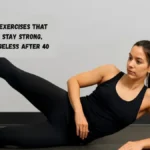A tough HIIT class, a serious strength training session, or a half-day hike that makes you sweat can all be very good for your body. When you work out, though, you might feel sore the next day or for a few days after. What can you do to ease your pain if you experience soreness after a workout? What should you do to heal those muscles that hurt? It turns out that what you do to heal your muscles is just as important as what you do to work them out.
You won’t believe it, but sitting on the couch isn’t the best thing for sore muscles. For faster muscle repair and less pain, Everyday Health suggests six ways to heal muscles. These include passive recovery (that is, total rest; yes, it’s okay to put your feet up and watch Netflix) and getting enough sleep. You should also eat foods that are high in lean protein, complex carbs, and vitamins. Massage and foam rolling can also help you get better faster. Last but not least, exercise can really help you when you’re feeling sore, even though it might not make sense.
Low-intensity, low-impact exercise is the best way to go because it improves blood flow and muscle repair without putting the body under more stress (Everyday Health). In fact, a study in the Journal of Strength and Conditioning Research found that physical recovery was just as good at briefly easing muscle pain as massages.
1. Add Yoga to Your Cross-Training
According to Healthline, doing yoga in general is good for your body because it makes you more mobile, stronger, and more balanced and flexible. After working out, yoga can really help ease muscle pain. That’s because yoga moves your whole body through a number of poses and motions, which can help you loosen up, ease aches and pains, and become more aware of any imbalances in your posture.
Sharon Ng, a yoga teacher, told VeryWell Fit that adding yoga to your cross-training routine can help keep you from getting hurt and speed up the healing process. When you stretch, you can ease sore muscles and loosen up stiff muscles. This is because yoga makes blood flow and oxygenation better, which helps muscles heal faster (Yoga Journal).
According to Yoga Journal, Loren Fishman, the medical head of Manhattan Physical Medicine, says that the best way to deal with pain is to focus on the tight muscles and slowly work to loosen them up. Instead of overstretching muscles that are already tight, try doing easy yoga stretches to feel better. Forward bends while standing or sitting are a good place to start.
2. Go on a walk or an easy hike.
One easy way to stay busy while recovering is to go for a walk. It’s simple to do, and even a mild pace is good for you and helps your muscles repair. Healthline says that easy hiking, light running, and relaxed walking can all help ease muscle pain and stiffness by improving blood flow and circulation.
NBC News says that light exercise can also help the body’s inflammation process. NBC News talked to Matt Unthank, an exercise physiologist and qualified strength and conditioning expert. He said that it helps the body by “lymphatic draining, moving immune cells, and clearing inflammatory mediators.”
Speaking to Well+Good, Flexit master trainer Branko Teodorovic said, “Walking transports all the nutrients necessary to ‘feed’ the muscles in your legs and to replenish glycogen, our muscle energy.” Moving around also breaks up lactic acid buildup, which makes your muscles better prepared for the next workout. Teodorovic says that, as a general rule, 20 to 30 minutes of slow walking will help ease muscle pain (via Well+Good). It’s also a great way to work out every day.
3. Hop on Your Bicycle for a Gentle Ride
Another great physical healing exercise is cycling at a steady pace. Everyday Health quotes Nicole Belkin, an orthopedic surgeon at New York-Presbyterian at Columbia University Irving Medical Center, who says that cycling is a low-intensity cardiovascular exercise that improves circulation and helps the body get rid of waste products that come from high-intensity exercises. Cycling can help fix muscles in the same way that walking can, but it’s important not to overwork your muscles or get too tired (EverydayHealth).
It’s easy on the knees, legs, feet, and joints to ride a bike because it has low impact. Jessica Schwartz, a spokeswoman for the American Physical Therapy Association, told the Arthritis Foundation that when you cycle, your legs move in all directions, which makes synovial fluid, which keeps the joints smooth. Cycling is also good for the bones because it puts less stress on the muscles, joints, and tendons (per Self). Plus, Self says that all it takes to get fit is ten minutes of riding every day.
4. Swim A Few Laps In The Pool
Without a doubt, swimming is the best way to heal muscles. Swimming is good for your muscles and joints, and Healthline says it may even help lower swelling. Terry Fritch, head coach of Life Time Swim of North Carolina, says that swimming is a low-impact exercise that works all of your muscles and joints in ways “that you may not be able to do on land” (source: VeryWell Fit).
In 2010, the International Journal of Sports Medicine released a study that looked at how swimming could help people heal from running. Nine triathletes took part in the study and ran two sets of high effort. After ten hours, one group went swimming to recover, while the other group did nothing but rest. More improvement was seen in the runners of the triathletes who swam than in those who did not.
Swimming is an easy way to get some exercise and help your body heal. VeryWellFit recommends swimming for 20 minutes, starting with breaststrokes and kicks to warm up. Then, swimming freestyle for 50 to 100 meters and finishing with a 100-meter rest.
5. Do Some Resistance Band Training
When you do circuit training again, try using resistance bands for a set of active recovery movements in between your high-intensity sets. The headline says that your muscles will thank you later.
The American Council on Exercise released a study that put this idea to the test with athletes who ran or rode bikes until they were completely worn out. It was discovered that athletes who kept working out at 50% of their original energy level after they felt tired recovered faster than those who stopped working out altogether.
Healthline says that working out with resistance bands the day after a hard workout is another great way to cross-train. To change the level of resistance, simply use bands that are softer or tighter, add or remove bands if you use more than one on the same place, or move the band around on your body (Women’s Health). Also, it works out your whole body well.
6. Practice Gentle Stretches
Stretching has been shown to help with pain for a long time. “People don’t give stretching and flexibility enough credit,” says Rick Sharp, an exercise physiology professor at Iowa State University in Ames. Sharp says that stretching stops the muscle from going from being sore to twitches to being tight.
Remember that stretching is not a magic bullet for pain. It takes time for muscles to fully heal, whether you stretch them or not. It can help you get better, though, to stretch. Bustle says that the best time to stretch is right after a workout to help your muscles heal and get more blood to them. There are three types of stretching, according to the International Journal of Sports Physical Therapy.
These are static stretching, active stretching, and passive stretching. All of these can help with range of motion, but more study is needed to find out which one helps with delayed onset muscle soreness the most. Adidas says that the best way to loosen up muscles after a workout is to do motionless stretches. As you slowly stretch your muscle until you feel a pull. Hold for 20 to 90 seconds.




